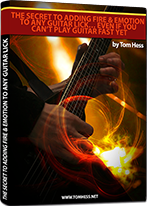Songwriting - Part 1
by Tom Hess
Emotion To Any Guitar Lick

EMAIL TO GET ACCESS
By submitting your info, you agree to send it to Tom Hess Music Corporation who will process and use it according to their privacy policy.
Most people approach songwriting in the same general way.
The most common process for many is to go to their instrument and improvise until they stumble upon something that sounds good. A lot of great music was written this way.
However: this way of composing is very limiting.
Fact is: you can start your songwriting focus in no less than 8 ways. These include: starting with chords, melody, chords & melody together, rhythm, dynamics, timbre, texture and form.
Before we explore each method in details: What are the advantages and disadvantages of writing music by “improvising on your guitar”?
Emotion To Any Guitar Lick

EMAIL TO GET ACCESS
By submitting your info, you agree to send it to Tom Hess Music Corporation who will process and use it according to their privacy policy.
This Method's Advantages
- This is the easiest songwriting process for most songwriters.
- You can begin immediately (without little or no pre-compositional planning or thought).
- You can take advantage of the guitar's natural possibilities of tone, playability, pitch range, the number of pitches that can be played simultaneously, dynamic range, articulation, etc.
- If you are a competent guitar player, you can easily create music that is natural for the guitar. You probably have at least a basic command of general guitar, so playing your guitaristic ideas won't be a major problem in most cases.
- Because most songwriters (even many pros) write in this way, your "musical" results may be similar to some of those that have gone before you and written successful hit songs.
This Method's Disadvantages
- You are limited by the instruments limitations of tone, playability, pitch range, the number of pitches that can be played simultaneously, dynamic range, articulation, etc.
- You are likely to repeat similar ideas that you have used before in other songwriting sessions.
- It is easy to fall into the trap of thinking like a guitar player only versus a songwriting musician.
- You may discover your hands are doing most of the creating, not your true creative mind.
- The range of possible musical results is limited when using this single process exclusively. Not necessarily because there is anything wrong with the guitar or you.
Any single songwriting process will be limiting. You must really work hard to squeeze as much out of a single process as possible. Of course having multiple processes is better than having only one (I will discuss other methods of writing songs in future articles).
Go to your instrument and begin improvising, notice what types of things you do naturally. What is the process that you usually start with? Do you begin by trying to write a melody? Or do you begin with chords? Here is a list of ideas you can use to begin.
Begin With Melody First
- In this case, decide if the melody you are trying to write will be a vocal or instrumental melody. This is very important because vocal melodies need to have room for a singer to breathe and you must also consider the pitch range - a singer's pitch range is more narrow than most instruments. Keep this all in mind when writing melodies.
- Consider the melodic contour (shape and direction) of your melodies.
- Is there a clear climax (high point)? Where should it be in the melody?
 Become A Much Better Songwriter
Become A Much Better SongwriterLearn new and innovative ideas to
quickly improve your songwriting.
 Improve Guitar Playing Creativity
Improve Guitar Playing CreativityLearn the main reasons why you
struggle to be creative on guitar.
 How To Create Killer Guitar Licks
How To Create Killer Guitar LicksGet tons of new ideas to improve your lead guitar playing creativity.
Begin With Chords First
- Choose a tonal center (key) to begin with. You don't have to stay in that key for the entire song, but it is wise to at least begin in a single key. You can deviate from the key later if you wish.
- Think about the progression of chords, where are there moments of tension and resolution? Are these moments placed in the best order?
Begin With Chords And Melody at The Same Time
I like this one a lot. Begin with a single chord and a melody note or phrase, as you add on the next chord and more melodic notes, write them together. Experiment by changing the chord but not the melodic phrase. Experiment by changing the melodic phrase but not the chord.
Begin With Rhythm First
- Consider the types of rhythmic patterns that you normally use. Perhaps one of them is exactly what you need to get into the groove of a new song.
- Experiment with variations on your favorite rhythmic patterns. Take a common pattern and play it backwards.
- Create something totally new. Force yourself to disallow any of your favorite rhythmic patterns to creep into your new song idea.
Dynamics, Texture and Form are the most often overlooked musical elements among songwriters. Record companies hire producers to improve the quality of the songwriting done by the writers. Most producers have to spend a lot of their time (and the artist's advance money!) shaping the songs in these three areas because songwriters often neglect to spend enough time and effort on them. Most people can write a melody and put chords together, but struggle with dynamics, texture and form.
Begin With Dynamics First
- If you are thinking about dynamics while composing each part of the song, you are already ahead of the game.
- Plan out what the dynamic range of each section of your new song will be. Which parts will be louder and which will be softer? How can you create smooth transitions between them? Do you want "smooth" transitions?
Begin With Timbre First
The variety of instruments you use, and the sounds you get out of those instruments brings color to your music. Once you have written a melody, experiment with how many different types of tone qualities you can use to play it. Even if you are only writing a song for a solo instrument, how can you "color" the sound with that instrument? For example, on a guitar, playing down by the bridge produces a totally different sound quality than picking over the center of the string (12th fret).
Begin With Texture First
The density of sound and timbre may influence the types of melodies you compose. Consider how the density of texture may change from section to section. What type of musical effect will result? A single guitar line might lead you to write guitaristic lines, but if you use a guitar to compose a keyboard part, your approach will often be (and probably should be) quite different.
Begin With Form First
Starting here can do wonders to keep you out of trouble (musically speaking). When you don't think about the form (arrangement of the parts of a song) early on in the writing process, it is easy to paint yourself in a corner later. When you have written various parts for a song but can't seem to piece the individual parts together in a cohesive manner this usually happens because there was little or no thought about form early on in the writing process.
If you liked this article, then you might find the following articles helpful:
 | Forward this article to your friends |

